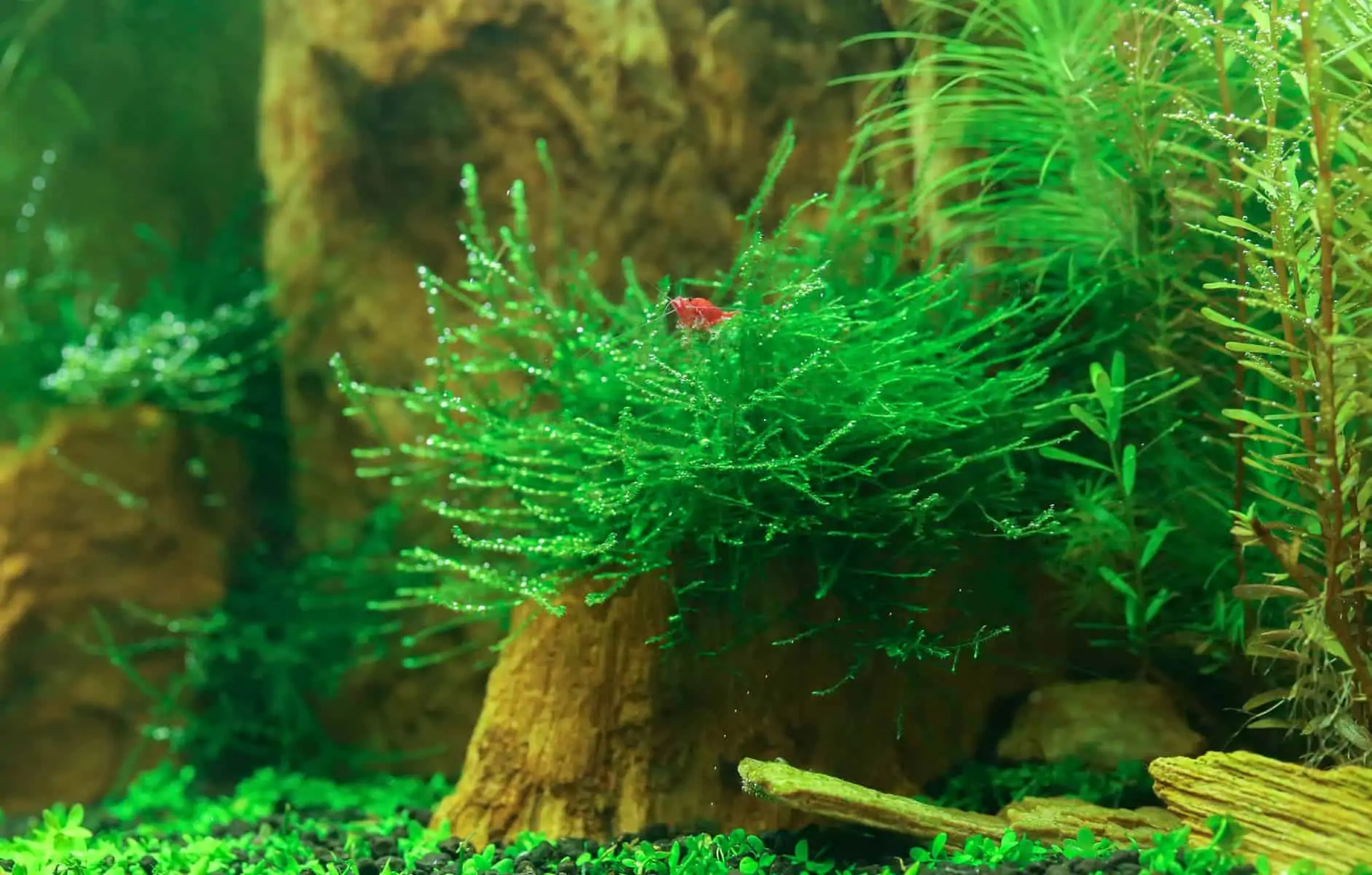Java moss is one of the most popular aquatic plants in the fish-keeping hobby. The plant is relatively small, hardy, and easy to grow, making it a good choice for a beginner.
But why is your Java moss plant turning brown? And what can you do to save it?
Keep reading to find out why your Java moss has lost its vibrant green color, and learn what you can do to fix the problem.
What Is Java Moss?
Java moss (Taxiphyllum Barbieri) belongs to the Hypnaceae family of plants that are found in southeast Asia.
In the wild, Java moss grows on rocks, tree trunks, and along river banks. However, the plant also grows submerged, making it an ideal choice for the aquarium. You can grow Java moss as a floating plant that works well as a spawning site for some species of fish.
Java moss is an attractive plant that is tolerant of water quality and can grow in medium-light conditions. The plant looks good and provides excellent cover for fry, small fish, and shrimp. Infusoria grow on the plant’s leaves, providing food for newly hatched fry.
Java moss is readily available and inexpensive to buy, which is another reason for its popularity.
Why Does Java Moss Turn Brown?
Thanks to its resilient, hardy nature, Java moss is rarely problematic. However, sometimes the plant can lose its green color and turn brown.
There are several common reasons why your Java moss plant might turn brown, including:
- inadequate nutrients in the aquarium
- excessive algal growth
- dirty conditions
- insufficient carbon dioxide levels in the water
Let’s take a look at those problems in more detail, together with tips on how you can prevent your Java moss from turning brown.
Does Java Moss Need Lots of Light?
Java moss doesn’t require strong light to thrive. The plant will do very well under low light, just like the Java fern.
Of course, more light means that your Java moss will grow faster, but too much light also makes it easier for algae to proliferate.
Insufficient Nutrient Absorption
One of the main problems with the Java moss plant is that its roots are somewhat sparse. The main function of the roots is to help the plant adhere to a rock or tree root for support. That means the plant mainly takes up nutrients through its stems and leaves.
When the leaves become too thick and dense, especially around the central area of the plant, their ability to absorb nutrients is significantly reduced. That causes the Java moss plant to turn brown. Look closely at your plant. If the leaves are turning brown in the central part of the plant, it’s likely that the plant has become too bushy and needs thinning out.
If the plant is unable to absorb sufficient nutrients due to a lack of water flow across the leaves, it will gradually turn brown from the center outward.
Excess Algae
Algae is an aquatic plant that grows in most fish tanks. Small algae growth can be beneficial, providing a food source for some fish species. However, too many algae take up excessive quantities of minerals, causing a shortage of nutrients for your other plants.
Many species of algae thrive in fish tanks for several reasons, including too much direct sunlight, poor water conditions, and insufficient tank cleaning.
If your tank has a large population of algae colonies, your Java moss can suffer from nutrient deficiency and will eventually turn brown. Algae also grow on plant leaves, depriving the plant of the light it needs for photosynthesis.
Dirty Leaves
Java moss and other plants can help to keep your fish tank clean by utilizing organic waste in the substrate as a kind of fertilizer.
However, the plant can accumulate deposits of leftover food and other debris across its leaves. Over time, those deposits prevent the plant from absorbing the nutrients it needs and also block out light. When that happens, brown spots start to develop on the plant’s leaves, and you’ll need to clean them gently.
Lack of Carbon Dioxide
Almost all aquatic plants, including Java moss, need carbon dioxide to photosynthesize. If the CO2 levels in the water are inadequate, the plant will be unable to create the food it needs to thrive, and the leaves will begin to turn brown.
In that case, you might want to supplement the CO2 levels in the tank by using a CO2 injection system. However, remember that many fish are sensitive to too much carbon dioxide in the water parameters, so tread carefully.
Inadequate Pruning
Interestingly, the Java moss plant can cause brown leaf discoloration. That happens if the plant is allowed to grow and spread excessively so that the leaves block out the available light in the tank. Too much growth can also make the plant unstable and dislodge it from its attachment site.
The most straightforward way to prevent those problems from affecting your Java moss plant is to prune it regularly with a set of aquascaping scissors. Pay particular attention to the central area of the plant, thinning out any dense growth so that the leaves receive plenty of water flow.
Not Enough Light
Java moss will grow under medium light. However, if the plant doesn’t get enough light, it will be unable to photosynthesize, and it will begin turning brown.
So, when you plant your Java moss plants, make sure you don’t position them so that other plants are blocking out the light. In addition, be sure to leave your aquarium light on for eight to ten hours per day.
Poor Aquarium Maintenance
Poor maintenance is not good for your fish tank or its residents, including your plants. However, dirty water will boost algae growth and increase the volume of bacteria and fungi in your tank, which will cause your algae to turn brown.
Incorrect Water Temperature
Water temperature is critical when it comes to the growth, propagation, and general health of all aquatic plants, including Java moss. If the water is too warm, the plant will begin to degrade, and the color will change.
You should keep the water temperature below 86 degrees Fahrenheit, ideally between 73 and 77 degrees Fahrenheit.
Stage of Growth
Java moss does turn brown at a particular stage of its usual growth. That’s to be expected. However, after some time, the plant will return to its usual color, so you’ll need to be patient and just wait.
Of course, if you prefer, there are several other kinds of moss to consider that don’t go through a brown stage, including Christmas moss, Willow moss, and Fessenden moss.
How Do I Keep Java Moss Green?

So, how can you keep your Java moss green?
Limit Fertilizers
All aquatic plants need some fertilizer and essential minerals to thrive. Most plants can derive what they need from the organic waste in your fish tank and light. However, many aquarists add fertilizer to their aquarium in the form of nutrient tabs or liquid fertilizer.
But adding too much fertilizer to your fish tank can cause problems. Too much of a good thing can cause Java moss plants to grow too quickly and produce thick leaves that can even reduce nutrient absorption, ultimately causing your plants to turn brown.
Control Algae
As previously mentioned, too many algae growing in your aquarium can reduce the nutrients that are available in the water for your plants.
The main cause of algal growth is excessive sunlight. So, the easiest way to stop algae is to move your fish tank to a spot that’s out of direct sunlight. However, if that’s not a practical solution, you should use drapes or shades to block out the light on sunny days. Your fish tank lighting will be perfectly adequate for your aquatic plants.
Growing more plants in your fish tank can also help to crowd out algae by depriving it of the nutrients it needs.
In severe cases, you might need to remove decorations from your tank and scrub them clean of algae. Infested plant leaves can be gently cleaned to remove algae, and you can clean your tank’s viewing panes with specialized cleaning equipment, such as an algae scraper or sponge.
Finally, you could add a few algae eaters to your setup. Algae eaters include certain fish species, snails, and shrimp. These creatures not only eat algae, but they also act as a cleanup crew, eating leftover fish food, plant debris, and other organic detritus. This helps to keep your fish tank water clean and the environment tidy.
Increase Carbon Levels
Your fish naturally release carbon dioxide into the water through respiration, which is great news for your plants. However, sometimes, the carbon levels in the water might be inadequate for your plant’s needs, and you’ll need to supplement them.
One easy option is to use a liquid carbon replicator product that can also help get rid of algae. Alternatively, you might want to consider using a CO2 injection system.
Tips To Prevent Java Moss Turning Brown
Here are a few more tips on how to stop your Java moss plants from losing their vibrant green hue and turning brown.
- Keep the water pH between softly acidic and neutral.
- Maintain the water temperature between 73 and 77 degrees Fahrenheit.
- Ensure good water flow throughout the aquarium.
- Run a filter system and provide the plants with clean water.
- Lightly fertilize the plants occasionally.
- Maintain adequate carbon dioxide levels without the water.
If you maintain a clean aquarium that has adequate lighting levels and the correct water temperature, your Java moss should flourish.
Final Thoughts
Did you enjoy our guide on how to prevent your Java moss from turning brown? If you did, please remember to share the article with other tropical aquarium enthusiasts.
Java moss is a hardy, easy-to-grow plant that makes the ideal choice of plant for beginners. As long as you provide your plants with a clean fish tank, the correct water temperature of between 73 and 77 degrees Fahrenheit, and adequate lighting, your plants shouldn’t turn brown. However, Java moss does turn brown as part of its natural growth process.
If you have any questions about how to grow Java moss, please feel free to ask them in the comments box below.


